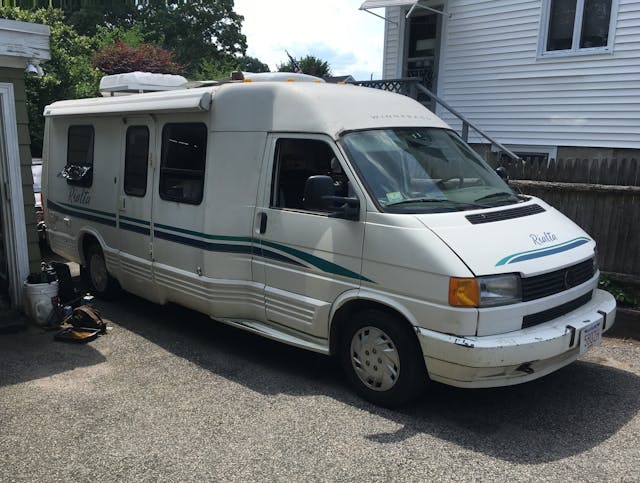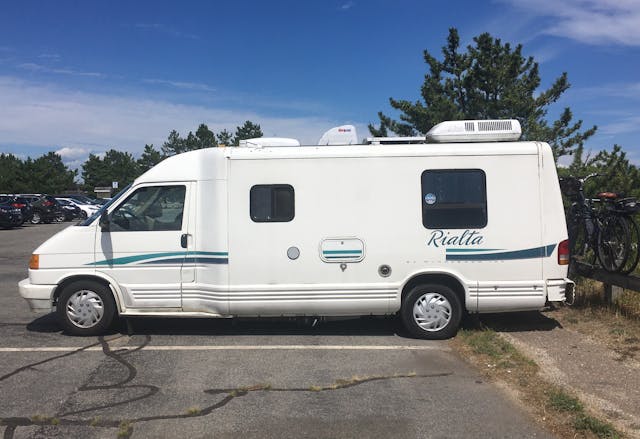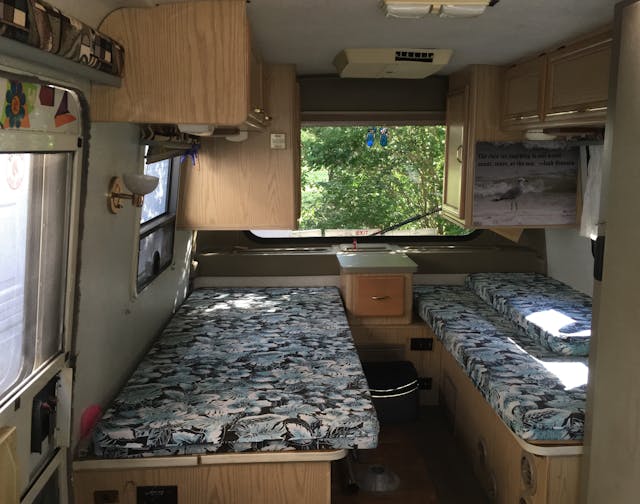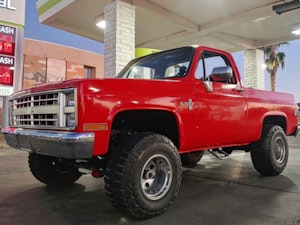Media | Articles
Mini adventures in a mini RV
It’s now been three years since I bought my Winnebago Rialta, the small RV that’s a Volkswagen Eurovan with a Winnebago camper body on it. RVs are funny commodities, as you can spend as much or as little for them as you want. It’s common for people to buy used RVs, take them on one or two trips, and park them in the yard—and before they know it, time ravages them.
The battery running down is just the beginning. Sunlight dry rots the tires, and the myriad vents on the roof cause leaks, and the interior begins to mildew. Add 40 gallons of bad gas to the picture and the result is something that’s often worth next to nothing. Because of this, you can essentially set your target price for an RV—right down to “free”—and find one for that price if you look. Perfect for a bottom-feeding do-it-yourselfer like me, right?

But even beyond degradation from lack of use, what you usually find at the shallowest end of the price pool is enough to make you move upmarket. The wood paneling in 30-year-old RVs are enough to make Walter White’s meth lab look like a spread from an Ethan Allen catalog. Even interior aesthetics notwithstanding, the other major issues with most cheap RVs are physical size and bad gas mileage. People think they want big RVs so they’ll have space for themselves and the family to spread out in, but once you get past about 24 feet, not only can’t you easily parallel-park them, you can’t even count on being able to drive them wherever you want. Forget following up on that restaurant recommendation or checking out that cool antique store. Unless there’s a big parking lot, you may need to keep driving. And moving all that bulk requires a big engine. For something big with a carbureted gas-swilling V-8, expect about six miles a gallon. Yes, fuel is cheap right now, but even modest day trips will set you back quite a bit in fuel costs.
Now, I’m a diehard BMW guy, so when I began looking for a small RV three years ago, I wanted a Vixen, which is the oddball boutique low-production brainchild of DeLorean designer Bill Collins that was powered by a BMW turbodiesel engine and had a five-speed manual transmission. It’s difficult to find Vixens in a condition that’s neither basket case nor babied with a $30K asking price. So I went down the rabbit hole of learning about inexpensive (around five grand), small (22 feet or less), fuel-efficient RVs. I learned that there’s the Winnebago LeSharo (the Renault-based predecessor to the Rialta), the many variants of the Toyota mini-motorhome based on the Hilux (the predecessor to the Tacoma), and really not that much else. I was intrigued when I learned about Rialtas, but they’re certainly not “inexpensive.”

The earliest 1995–96 Rialtas are 21 feet long and have a 100-horsepower five-cylinder Audi engine, so they’re nearly as anemic as the old air-cooled Volkswagen Westfalia campers of yore. These five-cylinder Rialtas seem to sell in the $8000–$14,000 range. For 1997, the Rialta’s length was increased to 22 feet, and a 12-valve 140-hp VR6 motor was introduced. I see these with asking prices between $15K–$25K. The most desirable models are the 2002–05 Rialtas with the 24-valve 201-hp VR6 engine. Asking prices for these are $25K–$35K.
Marketplace
Buy and sell classics with confidence
I was about to bid on a nice-looking Toyota mini-motorhome on eBay when our Rialta, a running late-1995 that needed some TLC, fell into my lap for $3500. My wife and I instantly loved its look, the European vibe of the interior that felt like the next size up from the Westfalia campers we used to own, its ease of parking, and the 18-mpg-ish fuel economy. We do have concerns, though, about the 100-hp engine. It’s fine around town and cruising at 65 on the highway, but the handful of times we encountered short, steep hills, we extrapolated what it would be like on the long hill climbs out west. It’s not that I bought it explicitly to do a big western road trip, but the idea of causing a miles-long backup is concerning. Of course, anything with a gas engine that claims to be fuel-efficient is doing it at the expense of power; I doubt that the little Toyota four-cylinder mini-motorhomes are much better on long hill climbs.

I decided that the best thing to do was to use the Rialta to let Maire Anne and I dip a toe in RV-related waters and decide whether or not we’re RV people, and, if so, whether this was a good-size RV for us.
So, after three years of RV ownership, let’s look at where we are.
How I maintain the RV
For my vintage cars, I live and die by my guideline of “The Big Seven”—that if I address ignition issues, fuel delivery issues, cooling system issues, charging system issues, belts, ball joints, and clutch hydraulics, I’ll inoculate myself to the most common on-the-road failures. For several reasons, it’s a bit different on the RV.
First, at 25 years old (with 104,000 miles), it’s not as old as my ’70s-era cars, so the ignition’s much more reliable and I don’t live in the same fear that the fuel pump’s about to die. I do make sure the serpentine belt isn’t cracked (and carry a spare), squeeze the coolant hoses to check if they’re getting pillow-y, look for antifreeze leaks, and inspect the boots on the ball joints, CV joints, and tie rods. But I tend not to prophylactically address “Big Seven” issues in the same way I do with the vintage cars.
And that, secondly, is because even though the Rialta is a small RV, it’s still too tall to fit in my garage. And even if it wasn’t, it’s too heavy to pick up on my mid-rise lift. So nearly all the work must be done in the driveway. I worry about jacking up and setting down a vehicle that heavy on an asphalt driveway, as jack stands tend to sink. And owing to the Rialta’s snub-nosed front-wheel-drive design, it’s not an easy vehicle to work on from under the hood.

Third, because, unlike passenger vehicles an RV is used when parked, much of the repair, maintenance, and modification work has gone into the RV systems. I replaced the original “three-way” refrigerator that ran off 110VAC, 12VDC, and propane with a marine-quality unit that has a Danfoss compressor whose native mode is 12V, and mounted a solar panel to keep the coach battery stack charged, ensuring the most efficient operation when parked and not connected to 110VAC shore power. Small things like keeping the water and sewage plumbing leak-free often become projects.
Fourth, unlike the passenger cars, traveling with a small floor jack isn’t enough to let you safely pick up a wheel to change a flat.
The big failure mode in Rialtas is the transaxle, generally caused by overheating and by not changing the supposedly-lifetime transmission fluid. The transaxle in mine was replaced at about 80K miles. Overheating issues, exacerbated by long hill climbs, are helped by installing an external transmission cooler. I will do this if we ever plan a big western road trip.
Unlike my vintage cars, I don’t travel with many spare parts and tools. Basically, I just try to feed it when it’s hungry, keep my road service account with Good Sam up to date, hope for the best, and use my Hack Mechanic skills when we’re parked and the awning won’t extend or the water pump for the sink won’t turn on.
How we use the RV
Due to both the Rialta’s low power, the overheating-prone transaxle, and some deferred maintenance issues, we haven’t jumped in it and headed for Red Mountain Pass in Colorado. Instead, we use it for short hops in New England, mostly at campgrounds near the beach. Massachusetts State Park campgrounds can cost only around $35 a night, if you can get a reservation. I’ll talk about those campgrounds below.
But the huge surprise has been the non-overnight uses of the RV. Maire Anne and I hadn’t ridden our bikes in ages, but the Cape is dotted with bike paths that follow old rail lines. I bought a couple of modern bikes with riding positions better suited to our 60-year-old bodies than our old drop-handlebar 10-speeds and mounted a bike rack in the Rialta’s trailer hitch. So we take a lot of day trips in the RV. And you know what? Buying a vehicle with a bathroom in it is the single smartest automotive decision I’ve made in decades. Simply being able to do some outside activity, like take a hike or ride on a bike trail and return to a vehicle with a bathroom in it, is a godsend, particularly in these COVID-19 times when we’re trying to stay isolated and safe.
In addition to the toilet, some of the things that separate an RV from a camper are rooftop A/C and an integrated generator. We’ve used those things surprisingly little. During the heat of the day, we’re typically not inside the RV; we’re at the beach or on the bikes. Being plugged into shore power at a campground eliminates the need to run the generator. And, when disconnected from shore power, the presence of the solar panel on the roof keeps the coach batteries charged enough to run the refrigerator. We don’t have an inverter in the RV (something that converts 12VDC to 110VAC), as inverters are inherently inefficient and drain the coach batteries quicker than 12V. I installed a small television that runs directly off 12V. Maire Anne and I both have 12V power supplies for our computers. The only other coach devices that must have 110VAC, requiring shore power or the generator, are the microwave and the water heater. The microwave sees little use, and water is also heated by the RV when it’s driven. Plus, the shower and the hot water tank in the RV are both quite small, so we prefer to use the showers in campground facilities. We’ll see if this changes due to COVID-19 concerns.

The size of the RV
With any RV, there’s a tug of war between the “R” and the “V.” Here’s how I’ve come to understand it.
When you’re driving, you’re in the “Vehicle” part of the “RV” functions. It’s here that the Rialta’s svelte 21-foot length shines. This is tiny by RV standards. It’s the same length as a Ford F350 long-wheelbase supercab truck. Driving-wise, it doesn’t feel that different from a standard VW Eurovan. It’s a great length for both general maneuverability and parking. I’ve never had to pass up on a destination because of narrow streets, tight corners, or inability to park. Even with a two-bike rack adding three feet to the rear, by choosing a parking space at the edge of a lot, I can still occupy only one space.

However, once you’re parked at a campground, RV park, or any other overnight destination, you’re into the “Recreation” part of the RV, and there, the space issues rise to the top. It’s not just number of beds and chairs. It’s that floor and storage space become paramount. I’m not a boat person, but I’m told that, in the boat world, people often say that they want four feet more boat. It’s like that with RVs and trailers. Once you live with them, their space limitations become palpable.
The Rialta’s trim size comes at the expense of both floor space and storage space. There are two small “closets” in the back where clothes can be hung, two cabinets along the upper sides that are packed with general supplies, two tiny kitchen cabinets, and a storage locker under one of the beds that requires the mattress to be tilted up. Unlike larger RVs, there are no external storage lockers. The little walkway between the twin beds gets completely filled by the Coleman “Road Trip” collapsible gas grill and the collapsible beach chairs. There’s really nowhere convenient to put fishing rods and a boogie board. There is a scant six linear feet of floor space from the back of the driver’s seat to the head of the beds. When we take our backpacks, canvas bags with supplies, and shoes and toss them inside, that’s it for the floor space. We wind up tossing things on the beds during the day and moving them up to the front of the coach at night. I strung a couple of netted marine hammocks for soft items like backpacks. If we ever take a longer road trip, we’re going to need to be much more diligent about putting things where they go.

So, yeah, another four feet really would be nice. If we were really on the road, I might take the trade-off against ease of parking.
Are we RV people?
Ah. The big question. It’s challenging to talk about this without wading into cultural and political stereotypes, but I’m going to try my best.
A lot of it comes down to what you mean by the words “camping,” “camper,” and “campground.”
Many of us with a history of backpacking felt that the word “camping” belonged to us, that anything less than a full-day’s hike into the backcountry, where you slept in a tent, cooked over a stove the size and weight of a wristwatch, and went without a shower for long enough that—when you emerged from the woods and strolled into a convenience store for a cold lemonade—other patrons moved two aisles over. Often the progression is that, once you have kids, “camping” becomes going to a national or state park and setting up a tent at a reserved site, which could be a secluded spot a short hike in but is more likely a tiny numbered plot large enough for your car, a tent, and little else, part of a kind of camping suburbia where the bathroom and shower facilities take the place of the mall. But still, if the park is called a “campground,” there’s some reasonable expectation that the area has some connection to nature in terms of the presence of trees and dirt, and that you’ll park your car, set up your tent, and feel like you’re in the woods. Sort of.

The VW Westfalia campers we used to own had a fold-out bed, small water tank, sink, icebox, propane stove, and pop-up table, but no toilet or shower and no stationary heat or air conditioning. These, and small lightweight pop-up camper trailers towable with a passenger car, are the next step—the gateway drug, if you will—from tents to RVs or big trailers. But still, you’re thinly separated from the wooded environment, with minimal amenities. You’re still roughing it. Sort of.
The next question is: How large are these campsites, and do they offer electrical hookups and running water? If they’re small—car sized—and have no power or water hook-ups, then they’re “campsites” meant for people to tent or stay in “campers.” But if the sites are big enough for a bus to back into, and if they have water and power hookups, then they’re “RV campsites.” And full-sized RVs are all about amenities. I’m not placing a value judgment on that, but it’s likely to up-play the RV and down-play the surrounding environment.
Even though many of us try to embrace new things, and with them, new people, I think that we all instinctively know who our people are. When I drove my Lotus Europa to the Lotus Owners Gathering (LOG) event in Sturbridge, Massachusetts, last summer, I knew almost instantly that the other vintage Lotus owners were my people—friendly, engaged, passionate, scrappy, thrifty, funny.
And while we’re on this camper-campground / find your people thing, what is the deal with RV and trailer model naming? On the one hand, you see rigs with nature and experience-embracing names like Sunset Trail, River Chaser, and Whippoorwill. But you also see aggressive names like Raptor, Puma, Cougar, Predator, Bullet, even Marauder. Do RV salesmen see you walking across the lot, approach you, and say, “I can tell by the cut of your jib that you’re a Marauder kind of guy,” or would they look at my sandals and try to sell me a Sandpiper?
So, with that context, I think you can probably understand why, of the campgrounds and RV parks we’ve gone to, the ones where we’ve felt most at home are the dense wooded ones with no power or water hookups, where we’ve been adjacent to people who are tenting or in Westfalias, or the sites where the campground is mixed-use with people tenting, in campers, and in small to mid-sized RVs and trailers (and as few Marauders as possible). The sites where we’ve felt the least at home are the sites with the least physical connection to the environment—parking lots filled mostly with bus-sized RVs and trailers, and no support for people tenting.
It’s surprisingly difficult to know what a site will be like until you arrive. Last summer, we went to a very popular RV site on the southern Massachusetts coast. The previous owner of our Rialta raved about it. You can roll out of your rig, walk for 90 seconds, and have your toes in the water. But with it that close to the ocean, there’s no tree cover. It was just a big asphalt parking lot. In contrast, we just came back from an overnight at a state campground near the New Hampshire border where tents, campers, and RVs coexisted near each other. It wasn’t dense and leafy, but the vibe was connected and warm.

So, are we RV people? I don’t think so. We’re ex-backpackers who have gotten soft and want a cold beer and a bathroom three feet from a soft bed. We want to see places while feeling at least as connected to the surroundings as we do to our little RV.
These days, the hot thing in small RVs are the Mercedes Sprinter van conversions, some of which have “slide-outs” that whip out a room, Swiss Army knife-style, when you’re parked, helping to mitigate the tradeoff between length and space. But you sure don’t see these anywhere near the sub-$10K range.
I think our little underpowered Rialta will be with us for a while. We may not be RV people, but it’s a handy vehicle to own that enables some fun choices. Maybe I’ll—gasp—just pay someone else to lift it up and install that transmission cooler. Next summer, if you see traffic backing up in the right lane of some long western hill climb, check for Massachusetts plates.
***
Rob Siegel has been writing the column The Hack Mechanic™ for BMW CCA Roundel magazine for 34 years and is the author of six automotive books. His most recent book, Just Needs a Recharge: The Hack Mechanic™ Guide to Vintage Air Conditioning, is available on Amazon (as are his other books), or you can order personally-inscribed copies here. His new book, The Lotus Chronicles, will be this fall.



















